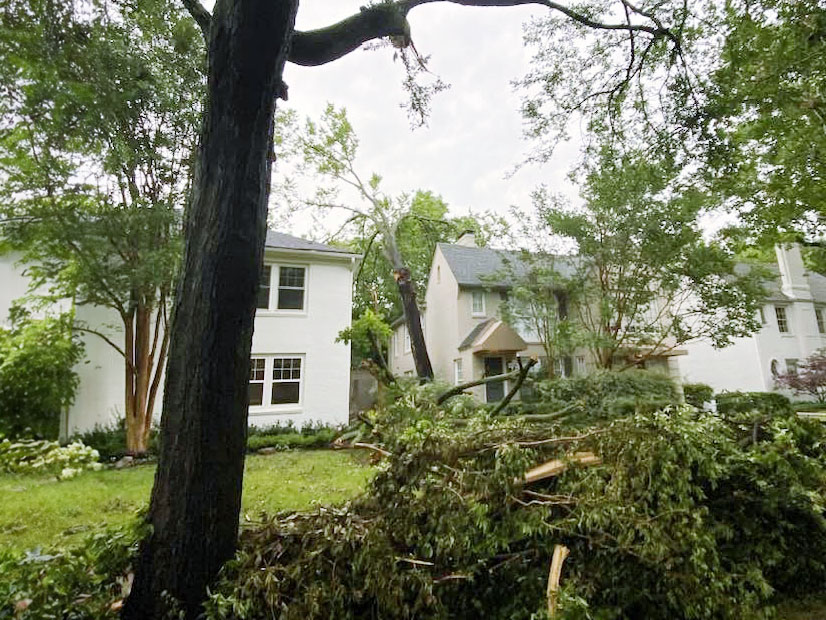
DALLAS — Attendees at a recent NERC and EPRI workshop on a draft standard addressing extreme weather’s effects on transmission planning now have a more personal understanding of those impacts.
Violent thunderstorms ravaged North Texas on May 28, the day before the workshop began, knocking out power to about 1 million Texans and leaving destruction in its wake. Several speakers and attendees were unable to fly into the Dallas area’s two airports after numerous flights were canceled. Those who did arrive found restaurants and entertainment options closed, thanks to the outages.
It didn’t get any better as the workshop adjourned May 30: Another line of storms rolled through the DFW Metroplex, forcing the cancellation or delay of flights out of the airports.
“It’s very ominous to begin a workshop focused on extreme weather with extreme weather,” Eknath Vittal, a senior principal technical leader in EPRI’s transmission operations and planning department and the workshop’s moderator, said May 29 in opening the workshop.
Vittal guided the diverse group of climate experts from national labs, research and development organizations, and other entities through a discussion of extreme weather and its implications for FERC Order 896 and NERC’s upcoming TPL-008 draft standard regarding extreme weather’s effect on transmission planning.
The commission’s 2023 order directed NERC to update TPL-001-5.1 (transmission system planning performance requirements) or draft a new standard by December 2024 that addresses a lack of long-term planning requirement for extreme weather events. (See FERC Approves More Extreme Weather Rules.)
FERC’s requirements included:
-
- developing benchmark planning cases based on major prior extreme weather events and/or meteorological projections.
- planning for extreme weather events using steady state and transient stability analyses expanded to cover a range of extreme weather scenarios, including the expected resource mix’s availability during extreme conditions.
- using corrective action plans that mitigate any instances where performance requirements are not met.
The NERC drafting team’s initial work product “failed miserably,” as PJM team member Michael Herman said, on its first ballot. The team is reviewing the comments it received before determining next steps, he said.
“We’ve been reading the comments that everyone has submitted about this,” Herman told his audience. “We’re taking that information and we’re working internally to process that information, and to determine what changes we need to make to the standard in order to address the concerns that all of you brought up.”
Herman says the drafting team will work to improve the standard’s language to better consider wide-area — entire reliability coordinator areas and critical flow and status information from adjacent RC areas — impacts and setting study area boundaries based on the benchmark events’ planning coordinator or planning coordinator requirements.
“In general, we see a lot of need here to bring online nuances to these studies, not just with respect to the defining the benchmark events, but actually the assumptions that go into the analysis itself,” he said.
A second draft is expected to be released for a second ballot in July. The drafting team will consider the need to define wide-area studies, bounding coordination requirements within a single interconnection and whether additional details are needed to specify addressing impacts on/from adjacent systems.
Vittal said the TPL-008 process won’t take as long as the original standard, which took five years to approve.
“Well, there’s the FERC directive behind it, so that kind of dictates the timeline in a way that might not apply to other standard-development processes,” he said. “That’s driving things at a little more pace.”
“This conference raises a lot of questions about how much data and how much analysis should be put into [the standard] because there’s a lot of assumptions and a lot of uncertainties that still require a lot of engineering and regulatory judgment,” said SPP’s Charles Yeung, executive director of interregional affairs.
He said the standard still will need a lot of work but that the workshop laid out a set of questions that will be tackled in the development process.
“I think it’s very valuable to do that upfront, rather than having to go through this iteration of postings and Q&A,” Yeung said. “This is definitely helpful because this is clearly something that’s not done in the planning horizon. So how do you translate all that analysis into a planning horizon? That’s going to be the challenge because the conditions and risks are very different going out far in the future than they are a week in the future.”
Creating the benchmark planning cases will require exchanging information on who develops the case, the weather variables that will affect inputs and assumptions, and how planning coordinators will coordinate case development with other PCs.
The standard drafting team envisions coordination among adjacent affected PCs to include sharing all applicable modeling and contingency data and understanding the benchmark event being studied by adjacent impacted PCs.
“Every time I talk to anyone in industry about what we’re trying to do … they’re so impressed because we’re trying to take on something that has not been done before,” said Soo Jin Kim, NERC’s vice president of engineering and standards. “When NERC first came into existence … it was in whether or not we had enough capacity on the system. That’s no longer the case anymore. Now with our changing resources, with almost all of the generation projects coming into the interconnection queues being renewable resources, we have to run our system very differently.”
Kim said other planning projects are on the horizon once TPL-008 is completed. She acknowledged the industry is “a little tired” of all the standards projects in play and asked for patience as NERC works to address severe weather effects.
“We do think it’s important that we continue to grow, and we continue to make sure that the momentum moves forward,” she said. “We’re now at a point where we have to keep up. I think it’s very important that we get ahead of the issue, and then we’re not playing catch-up for the next two years.”




